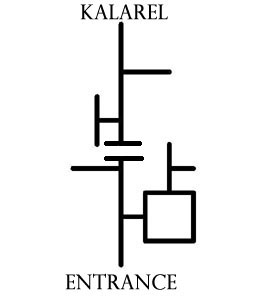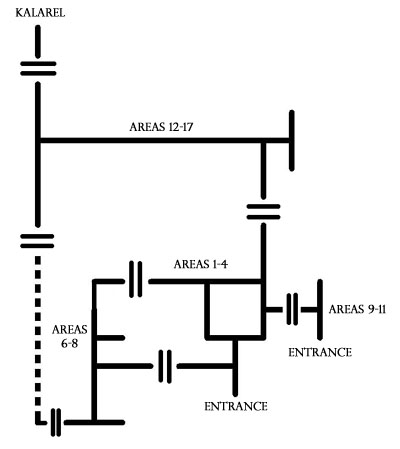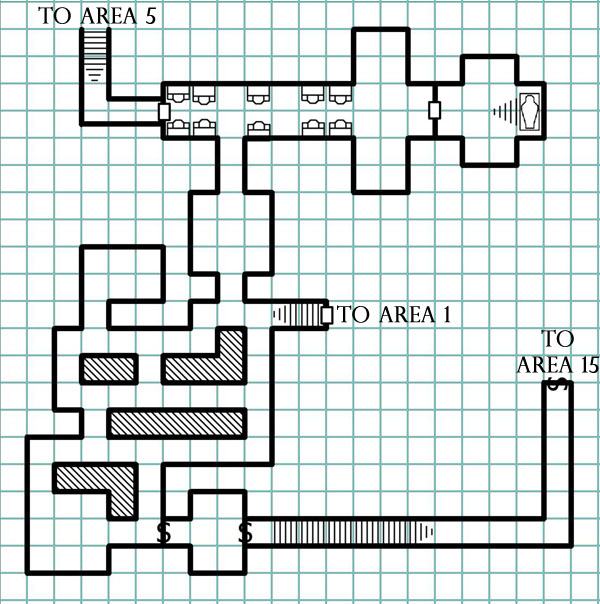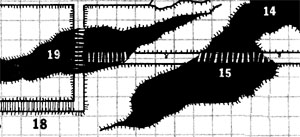We started with a linear dungeon:

But after xandering the Keep, the result is this:

Note that we haven’t changed the actual key to the adventure: We’ve just restructured the environment in which those encounters are placed.
I’ve also prepped some detail-light maps to make the changes a little clearer. You’ll want to cross-reference with the maps from the original module. (The original Level 2, which is now Level 3, is unchanged, so I didn’t re-map it.)


I’ll take a moment to note that this isn’t the only way we could have done this. Other things we could have done:
- Put a secret door at the bottom of the pit trap in area 1 (leading to one of several possibilities on the second level).
- Have the kruthiks tunnel from area 10 down to area 15.
- Put a teleport in Sir Keegan’s tomb keyed to a matching crypt on the second level.
- One of the prisoners in the torture chamber dug a hidden escape tunnel leading to area 6 (where he was killed by zombies, the poor bastard).
- Could there be a connection between the pool in area 11 and the water-based trap in area 16?
- Could the access to area 15 north of area 16 be a secret door, with a more obvious entrance leading from area 17 (allowing meticulous PCs to potentially bypass the trap)?
The particular revisions I’ve made simply struck me as either the most interesting or the most appropriate or both.
But the point of performing this revision on Keep of the Shadowfell is not only to salvage another aspect of this adventure. My primary goal is to demonstrate how easy it is to implement these techniques in your own dungeons. If we can take an existing, linear dungeon and fundamentally transform it in just a couple of minutes using a handful of xandering techniques, then the effect can be even more dramatic if we were to design a dungeon from the ground-up using those techniques.
Here’s a quote from a recent interview with Jennell Jaquays over on Grognardia:
The core inspirations for Caverns of Thracia were threefold. The first was to ally the various “beast” races of AD&D as a unified force. The second was to build encounters that took place in multiple levels of a cave, where the open upper areas were situated above open lower areas. The final inspiration (that I remember) was the rather primitive, but unique plate armor used by Mycenaean soldiers. These became the human guards of the upper reaches of the Caverns.
Of particular interest here is Jaquay’s second inspiration: I can personally testify to the effectiveness of these open caverns in transforming the typical dungeoncrawling experience. They immediately force the players to think in three dimensions, while their ubiquity significantly contributes to the memorable layout of the dungeon.

But the important revelation to be had here, in my opinion, is the effectiveness of clearly delineating a small list of concrete creative goals before beginning your dungeon design.
Building on that point, notice that Jaquays only specifies a single non-linear design technique in her list of creative goals. (And it’s actually a very specific variation of a generalized technique.) And although that is not the only non-linear technique employed in the Caverns of Thracia, Jaquays’ riffs on that theme are a definitive aspect of the module.
Here’s my point: Earlier in this series, I listed a dozen xandering techniques. Next time you’re designing a dungeon, don’t feel like you need to cram ‘em all in there. Instead, pick one of them and try to explore it in as many ways as possible while you’re designing the dungeon. (If you want a more focused experience, follow Jaquays’ example and try to narrow your design theme down to a specific variant of one technique – just like multi-level caverns are a specific form of unusual level connectors.)
Xandering your dungeon is easy. It’s also fun. And this applies to both the designing of the dungeon and the playing of the dungeon. Nothing is more exciting for me as a GM than to sit down at the table and know that I’m going to be just as surprised by my players as I hope that my players will be by me.
And when it comes to dungeon design, that’s the unique and exciting experience that xandering unlocks.
ADDITIONAL READING
Addendum: Dungeon Level Connections
Addendum: Xandering on the Small Scale
Addendum: How to Use a Melan Diagram
Dark Tower: Level Connections












ARCHIVED HALOSCAN COMMENTS
Sashas
I don’t usually comment, but I just want you to know how incredibly valuable I find your design essays. I’ve been DMing for 14 years now, and playing D&D for 16, and I still learn something new every time you write one of these.
Tuesday, August 03, 2010, 11:32:59 AM
Justin Alexander
Thanks for the feedback and the compliments! I really enjoyed putting the Xandering essays together, and was a little surprised/disappointed they didn’t generate a larger response. Good to know they were being read and appreciated. 🙂
Monday, August 16, 2010, 5:40:52 PM
Definitely appreciated.
Hello, I only just recently discovered your essays (About two days ago) and I must say, wow, they are quite simply mindblowing from my perspective. All of the ones I have read so far are comprehensive, without leaving out details and very entertaining.
It feels as though you learn something new with each essay. So I admire your work a lot, and I’d like to say that these [Xandering] essays in particular I enjoy very much, my only trouble with this (And your Dungeon Design essays) is that I become very envious of your mapping technique.
I enjoy the clean design and have seen it many other places, but I have yet to find a programme where it would be easy to do the things you do, maybe I just need to set up some program properly, but they all seem to have too much fancy and too little simple.
I’d very much like to know what you use for your maps (Both the traditional dungeon maps, and the Melan diagrams), and please, do keep up your brilliant work!
Thanks!
I use Dundjinni with the Old School art pack.
My experience with most computer mapping programs is that they tend to require massively more time to get the same results as mapping by hand with very little benefit. The Dundjinni + Old School art pack combo is the only one which allows me to map almost as quickly on the computer as with paper ‘n pencil, while substantially improving the quality of result that I get.
Very interesting articles on KoTS and [Xandering]. Thanks!
As a first time DM who is back in the RPG fold after not playing for 8 years, your articles are invaluable. I might put these [xandering] ideas to work to jazz up Sunless Citadel which I’d picked as a nice easy adventure to start myself off on… And now strikes me as being a tad too linear.
Sunless Citadel is a great example of a module that can be really easily spiced up with very minimal xandering:
– Put a door in the eastern wall of the room north of area 14. (This is one of the rooms keyed as #13.) This makes it possible for the PCs to meet the goblins and kobolds in either order (and also explains how the goblins get out of the compound in order to deliver apples).
– Put a hall between areas 33 and 36. (Adjust area 34 so that the hall will fit. Or have a short flight of stairs in area 33 that leads to a hallway passing under area 34.)
– Put a secret door between area 30 and area 32. The goblins and kobolds don’t know about this door.
Also, use a monster roster for the goblins and kobolds to run them as active forces.
I really enjoy reading your essays. The way you put together settings makes me want to try harder when I put dungeons together.
Great stuff! So much good info for aspiring GMs. Thanks!
A decade later I just found this. It’s super useful. I’m so happy to have found your site and look forward to exploring
Happy 2020
This series of articles have provided me with a lot of great insight I’ll surely put into good use!
I don’t quite understand the dungeon layouts you drew at the top of the article. Did you explain them in some other article that I’m not aware of? Because they seem quite handy
@Tomas
The origin of that diagramming method is mentioned in (very small) text under an example of it in Part 1 of this series.
https://web.archive.org/web/20150926064945/http://www.enworld.org/forum/showthread.php?168563-Dungeon-layout-map-flow-and-old-school-game-design
@Tomas, it’s a technique that someone named Melan invented. If you look at the previous article, there’s a link to an archived ENWorld post explaining it. Someone else posted a link in the comments to another site where the original post is also preserved: http://www.darkshire.net/jhkim/rpg/dnd/dungeonmaps.html
Incidentally, I recently stumbled across an article on another blog (which I’ve just now noticed is actually Melan’s own blog) that uses the same technique on one of Dyson Logos’ maps: http://beyondfomalhaut.blogspot.com/2020/05/blog-anatomy-of-dungeon-map.html
These are some of the most helpful ways to make dungeons more interesting. Thank you so much. I just need to find ways to prevent players from wanting to clear the whole thing:(
After reading this series, I decided to try using one particular technique, which was verticality. The central room of a dungeon I’m working on spans three levels, and splits off into several rooms, many of which contain alternate ways to move from level to level, including secret passages and loops that go back to the central room.